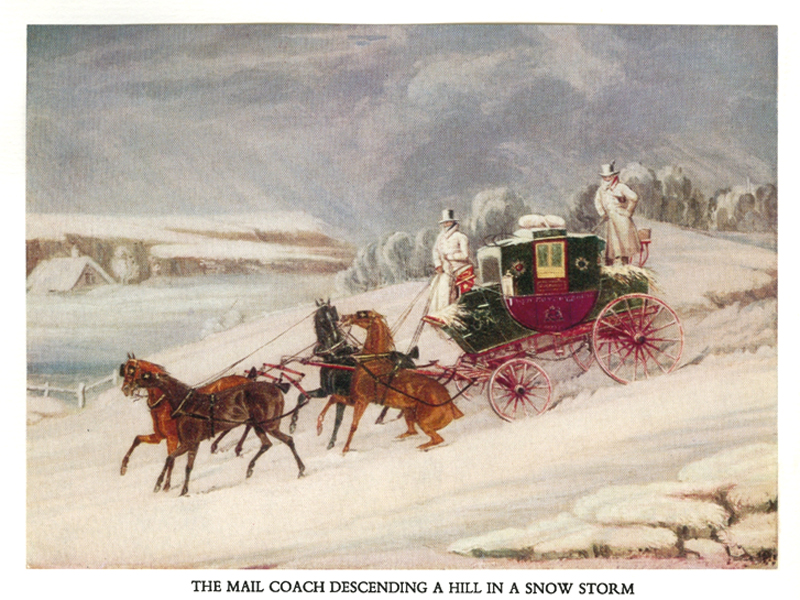

Carriages, wagons, etc. were used not only to transport people, but also to transport objects. For example, to carry wood, to transport in snow or on ice (sled or sleigh), carry hoses (fires), carry coal, logs, dogs, baggage and freight, food (with other wagons), drawn by one, two, four hoses or pony, stationed at hotels, as ambulances, milk-wagons, siege and cannon wagons, carrying ore, hearses, etc. Note: carts are two-wheeled carriages.
This information is primarily limited to England, focusing upon the Victorian era, with occasional references to earlier times. Clicking a live link below will show a painting, an etching or sketch, or a photograph of an example or examples of the appropriate vehicle.
A word about how these vehicles were powered. Carriages, coaches, and carts were typically powered by one, two, three, four, or six horses (cocking carts which were used to carry fighting cocks, used 3 horses in England and in Russia at this time, troikas or 3 horses powered sleighs existed, and surely 3 horse powered vehicles were used around the world at this time). Thus we are in an age when power was 1 Hp to 6 Hp). In mines, smaller horses or ponies were sometimes used to pull tubs of coal or iron on wooden, then iron tracks. Ponies were used, as the animals used had to be small enough to fit into the mine shafts. Thus fractions of a Hp were used as well. Of course, sometimes people constituted the power (for example, poor farmers and historically earlier stages of mining). This was the Victorian world! It is intriguing, that "omnibuses" were powered by horses before petrolium powered engines were used. "Trucks" were horse powered vehicles (soon to use petrolium powered engines). Similarly, "trains" on tracks like trolleys were powered by horses, later by steam engines driven by coal. The "evolution" of modern Industrialism can be seen, even if many novelists didn't pay too much attention to what was taking place before their eyes.
This is a disclaimer to any representation that the information provided here is a complete listing of all carriages, carts, coaches, etc. of interest to those who read Victorian literature. It is only hoped that this might be an aid to understanding the vehicles used for transport at that time.
Ambulance, flying hospital
Amempton
Barouche Landow
Battlesden-cart
Black Maria, Prison Van
Boulnois cab, Duobus
Brett
Brisker, Britska
Brougham, Double-suspension coup
Brougham-Hansom (Green machine)
Buggy, Buggie
Cab, Hansom
Cabriolet-Phaeton, cab-Phaeton, Milord (Mylord)
Chaise (shay), Gig, Dennett, Dennett gig
Clarence
Coach
Coach, flying
Coach, four-in-hand
Coach, mail
Cocking cart
Dennett, Dennett gig
Dog cart phaeton, dog cart, Whitechapel cart
Dray, Lorry, Lurry, Truck, Transfer Wagon
Droitzschka, Droshky, Drosky, Droshka
Fly, Fly-by-night
Gadabout
Gambo
George IV Phaeton
Gig, Chaise, Dennett, Dennett gig, Gorst gig
Gill
Go-cart (London, esp. Lambeth)
Governess cart
Grasshopper-chaise, Quaker chaise, Whiskey
Growler (four-wheel cab)
Hackney, Hack, Hackney-coach, Hackney-carriage
Hansom cab (Gondola of the streets), Hanson
Boon-Hansom
Brougham-Hansom
Victoria-Hansom
Shoful (counterfeit Hansom, imitation Hansom)
Hell-cart
Kittereen, Kitterine, Kittareen
(used in Kettering, Northamptonshire,
originally operated Christopher Treen, or Kit Treen)
Landow
Lorry, Lurry, Dray, Truck, Transfer Wagon (see Dray)
Lunch-wagon (where lunchrooms were not available)
Moore's High-Wheel carriages
Omnibus, Shillibeer
Phaeton
Basket Phaeton
Crane-neck Phaeton
Gentleman's Phaeton
Phaeton cart
Demi-Mail Phaeton
Equirotal Phaeton
Ladies' Phaeton
Mail Phaeton
Malvern Phaeton (Park Phaeton)
Perch high Phaeton
Physician's Phaeton
Pony Phaeton
Sociable
Stanhope Phaeton
Post-chaise (Po'shay), one horse shay, etc.
Quaker chaise, Grasshopper-chaise, Whiskey
Ralli-car, Rally cart, Clothesbasket
Robinson Hansom cab, Victoria-Hansom
Sedan cart
Stage wagon, Stagecoach
Stanhope Phaeton, Stanhope gig, Tilbury
Telegraph
Transfer Wagon, Lorry, Lurry, Dray, Truck (see Truck)
Trap
Tribus (similar to Hansom cab)
Truck, Lorry, Lurry, Dray, Transfer Wagon
Whiskey, Whisky, Gig, Grasshopper-chaise, Quaker-chaise, Dennett
Whitechapel cart, Dog cart phaeton, Dog cart
© Copyright 2006 - 2018
The Esther M. Zimmer Lederberg Trust
 Web Site Terms of Use
Web Site Terms of Use